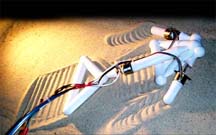Computer scientists have for the first time developed a robot that designs and builds other robots, almost without the help of humans. This is what the journal Nature reports today. In the near term, this development may lead to a new industry of cheap robots adapted to perform specific tasks.
New York Times

Computer scientists have for the first time developed a robot that designs and builds other robots, almost without the help of humans. This is what the journal Nature reports today. In the near term, this development may lead to a new industry of cheap robots adapted to perform specific tasks.
It is possible that in the long run these robots could develop into forms of "artificial life" that can reproduce and build improved versions of themselves. However, the development also raises concerns about a new breed of robots that will compete with humans.
"There are some things we probably can do but we shouldn't," said Bill Joy, chief scientist at Sun Microsystems, who recently wrote an article warning of the power of the new technologies.
For now, the robotic production system - a computer connected to a machine that builds plastic molds - in the laboratory of Dr. Jordan B. Polk and Dr. Hood Lipson at Brandeis University in Massachusetts, can create very simple robots: 20 cm long plastic structures with ball joints. When you attach a motor and a chip to the plastic structure, it can only do one thing: crawl slowly.
"They look like toys," said Dr. Polk, but "they were not designed by humans, and they were not manufactured by humans." "This is the first example of 100% automatic evolution of a machine," said Dr. Philip Hasbands, professor of artificial intelligence at the University of Sussex in England. "This is indeed a rather primitive example, but it is the first step to something of great significance."
The computer that built the robots had no idea what a successful robot model looked like. Instead, he was given a list of possible parts he could work with, and told to consider, among other things, the physical laws of gravity and friction. As in biological evolution, the computer added, removed and changed parts of the models. At the same time, he changed the software that should control the robot's movements. After each step, the computer ran simulations designed to test the models, and the most efficient models were the ones that survived.
After 300 to 600 "generations", the computer sent the model to the machine that built the robot. Then, in a step that requires human help, the researchers implanted a motor and a chip in the robot, and loaded the software written by the computer.
